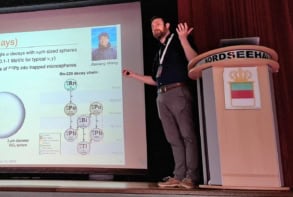
Scientists could be one step closer to understanding how life emerged on Earth, now that chiral molecules have been detected for the first time outside of the solar system. Chiral molecules, which play crucial roles in the chemistry of life, exist in two different structures that are mirror images of each other. Although the type of molecule detected (propylene oxide) is not a biological one, its discovery suggests that biologically relevant molecules could exist outside of the solar system. As well as suggesting that the precursors for life could exist elsewhere in the universe, the discovery could also help us to understand how chiral molecules – and life itself – emerged on Earth.
Just like human hands – which are mirror images of each other, but not identical – chiral molecules are referred to in terms of their right- and left-handedness. Chirality is an important property of life and most biological processes are “homochiral” – they are highly selective in terms of the handedness of the molecules involved. For example, most amino acids found in living organisms are left-handed, whereas most sugars produced by nature are right-handed.
Many scientists believe that chiral molecules were an important “prebiotic” precursor to life. Chiral molecules older than the Earth itself have been spotted in meteors and comets, which suggests that life may have extraterrestrial origins. As a result, astrobiologists studying the possible emergence of life on other planets are keen to understand where prebiotic chiral molecules are formed in the universe.
Missing line
This latest discovery was made by scientists working on the Prebiotic Interstellar Survey. They have caught sight of propylene oxide in the Sagittarius B2(N) interstellar cloud, which is about 390 light-years from the centre of the Milky Way. Propylene oxide has the chemical formula CH3CHCH2O and is used in the production of plastics. The team first spotted the molecule using the Green Bank Telescope, which is a radio telescope based in West Virginia. The researchers detected two spectral lines associated with the absorption of radio waves by propylene oxide. However, this was not enough evidence to be considered a discovery because they were unable to detect a third line associated with the molecule. This missing line was at a radiofrequency that is difficult to detect in the northern hemisphere, so the team joined forces with astronomers working on the Parkes Observatory in Australia – which detected the third spectral line.
This is…a pioneering leap forward in our understanding of how prebiotic molecules are made in the universe and the effects they may have on the origins of life
Brett McGuire, National Radio Astronomy Observatory
“This is the first molecule detected in interstellar space that has the property of chirality, making it a pioneering leap forward in our understanding of how prebiotic molecules are made in the universe and the effects they may have on the origins of life,” says chemist Brett McGuire of the National Radio Astronomy Observatory in Virginia, who did the study with Brandon Carroll of Caltech and colleagues. Carroll adds that “propylene oxide is among the most complex and structurally intricate molecules detected so far in space.” He says the discovery “opens the door for further experiments determining how and where molecular handedness emerges and why one form may be slightly more abundant than the other”.
Astronomers believe that complex organic molecules such as CH3CHCH2O form in interstellar clouds via several different processes. One process involves smaller, simpler molecules sticking to the surfaces of ice-coated dust particles, where the small molecules can join together to create larger structures. If the ice melts, the large molecules then become free to further react with molecules in the cloud and form even larger and more complex structures.
Polarized light
The radio-spectroscopy technique used to detect propylene oxide is unable to distinguish between right- and left-handed molecules, so the team cannot say if one handedness dominates the interstellar cloud. However, it may be possible to work out the chirality of the cloud by studying how polarized light interacts with the propylene oxide. A gas of chiral molecules will rotate the polarization of light passing through, which is how chirality was first discovered in the 19th century. Some scientists believe that exposure to circularly polarized light in space could result in the production of molecules with a specific chirality, which could then find their way to Earth and other planets via meteors and comets.
“By discovering a chiral molecule in space, we finally have a way to study where and how these molecules form before they find their way into meteorites and comets, and to understand the role they play in the origins of homochirality and life,” says McGuire.
The discovery is described in Science.



